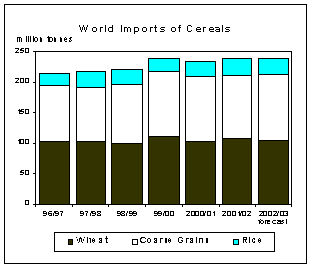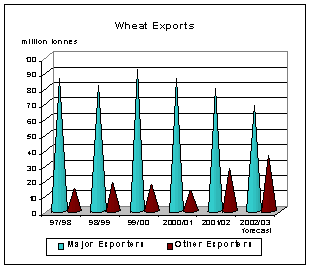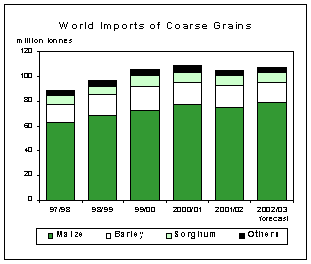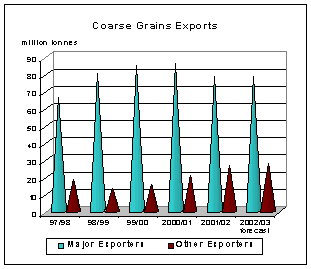


 |
 |
|
 |
||
|
|
||
|
|
|
|
|
| food outlook | |
| No. 1 | Rome, February 2003 |
|
Trade1/
The FAO forecast for world trade in cereals in 2002/03 has been raised by almost 4 million tonnes since the previous report to 240 million tonnes, but this is still about 3 million tonnes smaller than in the previous season's record volume. Larger than anticipated wheat purchases by the EU is the main reason for this month's upward revision. Nevertheless, global wheat trade would still remain below the previous season's estimated level. Cereal imports by the developing countries, as a group, are likely to increase slightly, while total imports by LIFDCs are expected to remain unchanged from the previous season.  World trade in wheat2/ in 2002/03 is currently forecast at 105 million tonnes, up 2.7 million tonnes since the previous report, but down 3.4 million tonnes from 2001/02. Aggregate wheat imports in Asia in 2002/03 are forecast at 44 million tonnes, down 3 million tonnes from the previous season. Most of the decline is expected in the Islamic Republic of Iran where, after a bumper wheat harvest in 2002, imports are forecast at just 3 million tonnes, down 2.6 million tonnes from the previous season and the lowest since 1998/99. Above-average production in Turkey is expected to result in a cut of about 600 000 tonnes in its imports, holding out the prospect of becoming a net wheat exporter again, after a brief interruption last season. Higher production is also expected to help Bangladesh to reduce its reliance on wheat imports this season by at least 400 000 tonnes. Wheat imports by most other Asian countries are likely to remain similar to the previous season except for the Philippines, where strong demand for livestock and poultry meat has increased the demand for feeds, resulting in larger imports of cheaper feed wheat from India as a substitute for maize. Overview of World Cereal Imports
Source: FAO
Total wheat imports by countries in Africa are expected to reach 26 million tonnes, up more than 1 million tonnes from 2001/02. However, Egypt, Africa's largest wheat importer, is forecast to import 500 000 tonnes less this year as a result of larger domestic output. By contrast, wheat purchases by Algeria and Tunisia are likely to increase sharply this season due to drought. Imports by Libya are also forecast to increase significantly, supported by a growing demand for processed wheat products. In the sub-Saharan region, total wheat imports (including food aid) are forecast to rebound to the 2000/01 level of around 9 million tonnes. Imports by Nigeria, the largest wheat importer in the subregion, are likely to remain stable at last year's level of around 1.7 million tonnes. However, imports by Ethiopia are forecast to surge this season in view of generally lower cereal output in 2002. Wheat imports by most countries in Latin America and the Caribbean are expected to remain unchanged from the previous season. Brazil, the largest importer in the region, is seen to maintain it imports of around 7 million tonnes. Wheat purchases have been restrained this season by the weaker Real, making imports more expensive. Given the rise in domestic wheat prices in Brazil, the Government has reduced the import tariff for wheat coming from outside the MERCOSUR from 11.5 percent to 10 percent, although Argentina is likely to remain the main supplier of wheat to Brazil. Wheat imports by Mexico, the second largest importer in the region, are forecast to rise slightly, driven by strong demand for processed wheat. In Europe, aggregate wheat imports are again likely to exceed normal levels to reach last season's peak of more than 13 million tonnes. The EU has already imported exceptionally large quantities of Black Sea origin wheat. While a near-record harvest in 2002 was initially expected to reduce EU imports in 2002/03, the forecast for imports has been raised and now stands at 10 million tonnes, similar to 2001/02. The introduction of wheat import quota from January 2003, which is primarily aimed at limiting imports of feed wheat from the Russian Federation and Ukraine, may restrain imports somewhat but the main impact is not expected until the next marketing season. Turning to exports, the exceptional surge in exportable supplies among non-traditional exporters continues to draw attention in world markets, particularly large exports from India, the Russian Federation and Ukraine, which surged to a combined total of over 13 million tonnes during the previous marketing season. Their exports in 2002/03 are likely to expand even further, exceeding 20 million tonnes, thus capturing 20 percent of the global market, as compared to 12 percent in 2001/02. The expected increase in exportable supplies from non-traditional exporters coincides with a major cut in supplies in Canada and Australia, both leading traditional exporters. In addition, the more competitive prices from the new suppliers have resulted in a significant diversion of purchases away from the United States, the world's largest exporter. However, a drop in the United States wheat production in 2002 has resulted in a tighter wheat balance and given way to a much faster rise in the US export prices. By contrast, large supplies in the EU are forecast to result in a strong recovery in export sales, although maintaining competitiveness in view of the continuing strength of the Euro against the US dollar may necessitate a more active use of export subsidies by the EU in the coming months.  World trade in coarse grains in 2002/03 is forecast at 108 million tonnes, up slightly from the previous season's reduced level. Among the major coarse grains, world trade in maize is forecast to rise to 79 million tonnes, but exports of barley and sorghum are now seen to decline slightly while trade prospects for rye and oats point to some expansion.  Coarse grain imports in Africa are likely to rise to around 18 million tonnes in 2002/03, up 3 million tonnes from the previous season. The increase is mostly driven by significant drops in production in several countries in the sub-Saharan region where millions of people are now estimated to be in need of urgent food assistance. Imports are forecast to rise most in Zimbabwe (up 1.6 million tonnes), Kenya (up 400 000 tonnes), Ethiopia (up 400 000 tonnes) and Zambia (up 255 000 tonnes). The food supply situation in the southern African region alone has increased global cereal food aid requirements (mostly maize) to 1.6 million tonnes, half of which has remained uncovered so far. In Zimbabwe, where half of the population is in need of emergency food assistance, food aid distributions remain slow. In Zambia, due to the tight domestic situation, the Government decided to waive its 15 percent import duty and the planned commercial imports by private millers at 150 000 tonnes are also expected to increase with the Government granting tenders for additional 300 000 tonnes. Total imports in Asia are forecast at 55 million tonnes, down slightly from the previous season. The anticipated decline is mostly in response to reduced import demand for maize and barley in the Islamic Republic of Iran, lower maize purchase by Syria and smaller barley imports by Saudi Arabia, the world's largest barley importer. Coarse grain imports by most other countries in Asia are forecast to remain unchanged from the previous season despite strong growth in feed demand, due primarily to large supplies of cheaper wheat which continue to weigh on demand for maize in some of those markets. Imports into Central America are forecast to reach 14 million tonnes, up 1.5 million tonnes from the previous season. The increase would be mostly associated with larger anticipated maize and sorghum purchases by Mexico. Total coarse grain imports by Mexico are likely to approach 11 million tonnes because of a small reduction in production and, more importantly, continued expansion of its poultry industry. In South America, total imports are expected to remain virtually unchanged from the previous season, at around 6 million tonnes. Imports by Brazil could again remain at relatively low levels, despite a decline in production and expected large exports. In Europe, total imports could reach 7 million tonnes, down slightly from the previous season, in light of an anticipated decline in barley purchases by the EU, which are forecast to decline sharply this season after an unexpected surge last year. In other regions, the drought situation on the Canadian prairies cut output and reduced supplies of coarse grains, increasing the need for imports of feed quality grains. As a result, in eastern Canada, imports of feed wheat have become an attractive option while, in the western parts, maize from the United States is regarded as the best alternative to cover this year's exceptional shortfalls. Similarly, a sharp drop in coarse grain production in Australia has severely reduced exportable supplies and, for the first time since the mid-1990s, prompted maize purchases from the United States. On the export side, with the anticipated small expansion in world trade and more limited exportable supplies in Canada and Australia, shipments from the United States, the world's largest exporter, are likely to increase slightly, even though production fell sharply in 2002. Larger exports are also anticipated from the EU where sales of rye, oats and barley are likely to rebound after a drop in the previous season. By contrast, maize exports from Argentina are forecast to remain below the previous year's level due to production shortfalls. In addition to the major traditional exporters just mentioned, China's presence in the world market would be even more pronounced this season with maize exports rising to 11 million tonnes, the third highest on record and the largest volume after the United States. Maize exports from Brazil will be smaller, but still above normal at about 2 million tonnes, despite a decline in domestic production. Maize exports from Hungary are also forecast to decline as a result of smaller production, but shipments from the Republic of South Africa, the largest net-exporter in Africa, are forecast to remain unchanged from the previous season. In the barley market, Ukraine and the Russian Federation will increase their exports again this season, capturing a 36 percent share of the global market, with their combined exports exceeding 6 million tonnes. Turkey is also expected to remain an important player in the global barley market, with exports around 700 000 tonnes, slightly more than in the previous season. 
FAO has raised its estimate of global rice trade in 2002 by 1 million tonnes to 27.4 million tonnes, in milled equivalent, a level close to the all-time record realized in 1998. The upward adjustment reflects a much higher estimate of exports by India, which are now believed to reach 6.5 million tonnes, up from the earlier forecast of 5.5 million tonnes and the largest volume ever dispatched by that country. Changes in the 2002 exports figures were also made for other countries on the basis of reported shipments. This was the case of China, where strong export activity during the latter months of the year has probably led to a repeat of the 2001 performance of 1.8 million tonnes, in spite of the contraction in output. Similarly, official estimate of exports by Thailand was lifted by 300 000 tonnes to 7.3 million tonnes. At that level, the outcome in 2002 would be only 200 000 tonnes below the record level achieved in 2001. By contrast, the estimate of Egypt's rice exports last year has been revised downward to some 400 000 tonnes, which would imply a 40 percent year-on-year reduction from the exceptionally high level of 2001, when exporters benefited from government export subsidies. On the import side, the higher trade estimate for 2002 reflects upward adjustments for Africa, where deliveries are now anticipated to reach a record 7.8 million tonnes, up by 500 000 tonnes from the earlier figure, and for Central America and the Caribbean.
FAO's forecast of international trade in rice in 2003 has been revised upward by 600 000 tonnes since the last report and now stands at 26.8 million tonnes. At this level, trade would be somewhat below the current estimate for 2002, with most of the difference attributable to an expected fall in exports from India and, on the import side, to smaller shipments to a number of traditional importers in Asia that gathered good crops in 2002 and to the African Continent. Part of the anticipated dip in trade in 2003 would be on account of smaller deliveries to Indonesia, which are now forecast to reach 3.2 million tonnes, 300 000 tonnes less than last year. The drop in imports there should be facilitated by the favourable production outcome in 2002 and could be more pronounced should the ambitious production target for 2003 materialize, especially in the light of the new tariffs, which were raised from Rupees 430 to Rupees 510 per kilo as of 1 January. The outlook is similar for the Philippines, which is expected to cut rice imports in 2003, consistent with current expectations of a record 2002 crop. Starting in 2003, the Government will allow the private sector, including farmers and local traders, to participate in importing activities alongside the National Food Agency, the sole importer until last year. However, this opening is not expected to boost purchases, since the Government will maintain strict control on the flow entering the country through non-tariff barriers, including registration, quantitative ceiling per trader, and penalties for supplies reaching the country beyond a certain time limit. In the Islamic Republic of Iran, the ending of the long-term drought that has gripped the country since 1999 and the expected recovery in 2002 production, should also prompt a fall in shipments during the current year. In general, rice trade with countries in the Near East could be disrupted should a military conflict start in the subregion. Current threats of an attack to Iraq were already reported to be delaying the clinching of trade deals between exporters and those countries. Expectation of a surge of imports by China Mainland, following the opening of a WTO preferential tariff quota did not materialize in 2002. Although the supply situation has tightened further, a sharp increase in rice purchases this year is not yet anticipated, with China's imports now forecast at 200 000 tonnes, the same level as in 2002 but down substantially from the previous 600 000 tonnes forecast. At that level, imports would be only a fraction of the preferential import quota of 3.79 million tonnes (2.6 million tonnes of long grain rice and 1.53 million tonnes of short and medium grain rice) that the Government agreed to open under WTO. By contrast, the Chinese Province of Taiwan is expected to buy the full 150 000 tonnes committed under the WTO minimum import commitment. Purchases by Bangladesh, which used to be a large rice importer, are again anticipated to shrink in the face of the large increase in production in 2002. Rice shipments to Africa are currently forecast to reach an overall 7.5 million tonnes in 2003, 300 000 tonnes more than previously reported, but somewhat below the revised estimate for 2002. The upward adjustment in 2003 mainly reflected higher forecasts for Kenya, Niger, Nigeria, Senegal and South Africa, while the import forecast was lowered for Côte d'Ivoire. From an historical perspective, imports into the region have been soaring since 1998, sustained by strong increases in consumption and relatively open import regimes. The small decline in imports foreseen for 2003, which would go against that tendency, is based on expectations of a decline in the volume flowing to the two major destinations in the region, namely the Côte d'Ivoire and Nigeria. In the Côte d'Ivoire, trade is foreseen to be constrained by the military conflict that has divided the country geographically and is hindering inland transportation of supplies. As for Nigeria, higher production in 2002 and the stepping-up of import tariffs last December might slow down the pace of imports. Little year-on-year changes are anticipated for the other major importers, including Senegal and South Africa, where shipments in 2002 were already high, at around 700 000 tonnes each. However, the above forecasts are still subject to a high degree of uncertainty in absence of official assessments of the paddy crops in 2002. Rice imports to Latin America and the Caribbean countries are forecast to reach some 3 million tonnes in 2003, about 350 000 tonnes more than earlier anticipated and similar to the revised volume in 2002. The adjustment to the 2003 figure reflects mainly increased shipments to Cuba, Mexico and Brazil. In the rest of the world, official estimates of imports by the United States have been somewhat lowered and are now close to the level of last year, while they were raised slightly for the European Union. As regards exports, the new trade figure for 2003 reflects larger expected shipments by Argentina, China and the United States, which more than offset downward revisions for Australia and Egypt. In the case of Mainland China, exports during the current calendar year are now expected to reach 2 million tonnes, 700 000 tonnes more than the previous forecast and 200 000 tonnes up from 2002. Despite falling production in the past seasons, domestic prices have remained fairly low, as supplies have been released from stocks. Since the same strategy is likely to be followed in the course of the year, it should enable the country to keep sales abroad relatively buoyant in 2003, barring a large production decline or tumbling international prices. Similarly, the forecast of exports from the Chinese Province of Taiwan has been raised to 100 000 tonnes, following the announcement of food aid commitments. Favourable crop prospects in Argentina in the coming season could also sustain a 25 percent recovery in its exports, which are now foreseen to reach 350 000 tonnes, 50 000 tonnes more than earlier anticipated. The official outlook for the United States has also been raised by 200 000 tonnes to a record 3.4 million tonnes, based on expectations of larger paddy sales to some Latin American countries, especially Mexico and Brazil. This improved outlook contrasts with deteriorating prospects for exports by Australia and Cambodia, in the face of the severe production shortfall expected this year, and by Egypt. Expected shipments from Australia have been halved to a mere 200 000 tonnes, which would be the lowest level since 1976. For Cambodia, they were lowered from 100 000 tonnes to 60 000 tonnes. For Egypt, exports are now anticipated to reach 600 000 tonnes, down 150 000 tonnes from the previous report, which would still imply a 50 percent increase from the previous year. Little change was made to the 2003 export forecasts elsewhere. Thailand shipments in 2003 are currently expected to equal the 2001 record of 7.5 million tonnes, which would imply an increase of 200 000 tonnes from last year. The forecast for India remains at 4.5 million tonnes, a level relatively high for the country but well below the revised 6.5 million tonnes shipped in 2002, which propelled the country to the second position among exporters. The sharp drop in production in 2002 and the recent announcement of increases in sale prices from the Food Corporation of India all point to a reduction in exports this year. Unlike for Thailand and India, sales from Viet Nam are anticipated to expand strongly in 2003, following the gathering of a record 2002 crop. Export prospects for Pakistan, at 1.5 million tonnes, point to a small recovery from the depressed level of last year, but far below the 2 million tonnes the country shipped annually between 1997 and 2001. Similarly, exports from Uruguay are expected to partly recover during the year. 1. World trade (exports) in wheat and coarse grains is based on a July/June marketing season, while trade in rice is based on January/December (calendar). 2. Including wheat flour in grain equivalent. |
||||||||||||||||||||||||||||||||||||||||||||||||||||||||||||||||||||||||||||||||||||||||||||||||||||||||||||||||||||||||||||||||||||||||||||||||||||||||